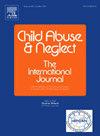以创伤和暴力为基础的亲密伴侣暴力护理的可接受性和可行性
IF 3.4
2区 心理学
Q1 FAMILY STUDIES
引用次数: 0
摘要
背景/目的亲密伴侣暴力(IPV)和儿童身体虐待经常同时发生,但对遭受 IPV 的儿童却没有进行常规的虐待评估。此外,IPV 幸存者通常会为他们的孩子寻求治疗,但不会为自己寻求治疗,这使得儿科就诊成为解决 IPV 问题的一个机会。我们开发了一种基于创伤和暴力知情护理(TVIC)的模式,该模式1)评估暴露于 IPV 的儿童,2)将幸存者护理者与 IPV 倡导者联系起来,我们旨在评估该模式的可行性和可接受性。参与者因遭受 IPV 而向儿童保护服务机构(CPS)报案的儿童及其幸存者照顾者。方法为了考察可行性,我们计算了以下两方面的百分比:1)符合评估条件的儿童;2)在儿童就诊期间与 IPV 倡导者会面并与倡导者进行后续联系的照顾者。为了评估可接受性,我们对 30/41 名照顾者进行了定性访谈,了解他们对该模式的看法。结果从 7/1/20 到 6/30/22,216 名符合条件的儿童中有 49 名(22.7%)接受了评估。在 41 位照顾者中,有 6 位已经在接受 IPV 服务;在其余 35 位照顾者中,有 24 位(68.6%)与 IPV 倡导者进行了会面,有 22 位(91.7%)与倡导者进行了≥1 次后续访问。看护人是出于对儿童行为的担忧和遵守 CPS 规定的愿望而进行探访的。由于医疗服务提供者建立了融洽的关系,并在不做评判的情况下提供了支持,因此参与度很高。结论:基于 TVIC 的模式是可行的、可接受的,可以提高看护者参与评估暴露于 IPV 的儿童是否受到虐待以及参与 IPV 服务的积极性,而 IPV 服务具有改善安全和促进福祉的潜力。本文章由计算机程序翻译,如有差异,请以英文原文为准。
Acceptability and feasibility of trauma- and violence-informed care for intimate partner violence
Background/objectives
Intimate partner violence (IPV) and child physical abuse frequently co-occur, yet IPV-exposed children are not routinely evaluated for abuse. Furthermore, IPV survivors often seek care for their children but not for themselves, making pediatric visits an opportunity to address IPV. We developed a trauma- and violence-informed care (TVIC)-based model that 1) evaluated IPV-exposed children and 2) linked survivor-caregivers to an IPV advocate.
We aimed to assess the feasibility and acceptability of the model.
Participants
Children < 3 who were reported to Child Protective Services (CPS) for exposure to IPV and their survivor-caregiver.
Methods
To examine feasibility, we calculated the percentage of 1) eligible children evaluated and 2) caregivers who met with an IPV advocate during the child's visit and followed up with the advocate. To assess acceptability, we conducted qualitative interviews with 30/41 caregivers about their perceptions of the model.
Results
From 7/1/20–6/30/22, 49 (22.7 %) of 216 eligible children were evaluated. Of 41 caregivers, six already were receiving IPV services; Of the remaining 35, 24 (68.6 %) met with an IPV advocate, and 22 (91.7 %) had ≥1 follow-up visit with an advocate.
We identified three themes: 1) Motivations for the visit, 2) Engagement with the model, and 3) Benefits. Caregivers attended the visit due to behavioral concerns about the child and a desire to comply with CPS. Engagement occurred as medical providers established rapport and provided support without judgment. Benefits included recognizing the impact of IPV on the child and immediate linkage to advocacy services.
Conclusion
A TVIC-based model is feasible and acceptable and could improve caregivers' engagement with the evaluation of IPV-exposed children for abuse and with IPV services, which have the potential to improve safety and promote well-being.
求助全文
通过发布文献求助,成功后即可免费获取论文全文。
去求助
来源期刊

Child Abuse & Neglect
Multiple-
CiteScore
7.40
自引率
10.40%
发文量
397
期刊介绍:
Official Publication of the International Society for Prevention of Child Abuse and Neglect. Child Abuse & Neglect The International Journal, provides an international, multidisciplinary forum on all aspects of child abuse and neglect, with special emphasis on prevention and treatment; the scope extends further to all those aspects of life which either favor or hinder child development. While contributions will primarily be from the fields of psychology, psychiatry, social work, medicine, nursing, law enforcement, legislature, education, and anthropology, the Journal encourages the concerned lay individual and child-oriented advocate organizations to contribute.
 求助内容:
求助内容: 应助结果提醒方式:
应助结果提醒方式:


